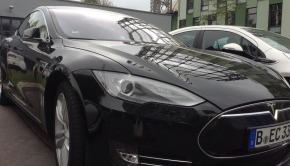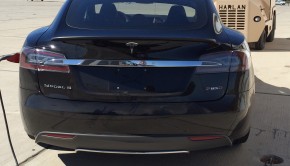What Does A SolarCity/Tesla Storage System Cost?
November 3rd, 2014 by Zachary Shahan
 We’ve written about SolarCity’s residential and commercial storage systems a couple of times before. But I don’t think I’ve ever seen a price tag on these. If you go to SolarCity’s home energy storage page, you can see that it asks you to “Get a free quote.” Not having a home in the US (and my legal home base in Florida not being in SolarCity territory), I couldn’t really do so even if I had thought to, but one of our readers (Kyle Field) actually went and got a quote.
We’ve written about SolarCity’s residential and commercial storage systems a couple of times before. But I don’t think I’ve ever seen a price tag on these. If you go to SolarCity’s home energy storage page, you can see that it asks you to “Get a free quote.” Not having a home in the US (and my legal home base in Florida not being in SolarCity territory), I couldn’t really do so even if I had thought to, but one of our readers (Kyle Field) actually went and got a quote.
The first thing Kyle found out is that SolarCity is only offering the residential storage solution to SolarCity customers at this moment (“due to limited supply of batteries”).
Even so, he did get some figures that would apply to his case if he was an existing SolarCity customer (he has solar but got it elsewhere, btw). He could (hypothetically) get a 10-kWh Tesla battery (to power the refrigerator, lights, etc. in a power outage) under a 10-year lease for a $1500 upfront cost + $15/month. That amounts to $3300 over 10 years. Not super cheap, but is actually less than I would have guessed off the top of my head. I’m curious to see how much the price for this comes down by the time the Tesla & Panasonic Gigafactory is pumping out batteries. I imagine it will come down a lot, as SolarCity has said that it plans to sell battery storage with every solar system within 5-10 years.
Image Credit: SolarCity
Keep up to date with all the hottest cleantech news by subscribing to our (free) cleantech newsletter, or keep an eye on sector-specific news by getting our (also free) solar energy newsletter, electric vehicle newsletter, or wind energy newsletter.
-
Garn
-
TedKidd
-
Patrick James Bayham
-
Ray Boggs
-
Kyle Field
-
Ray Boggs
-
Kyle Field
-
Ray Boggs
-
GCO
-
Bob_Wallace
-
-
eveee
-
Ray Boggs
-
eveee
-
Ray Boggs
-
eveee
-
-
-
GCO
-
-
Offgridman
-
Ray Boggs
-
-
-
EVcine
-
Kyle Field
-
EVcine
-
Bob_Wallace
-
EVcine
-
-
-
-
Larmion
-
EVcine
-
Kyle Field
-
EVcine
-
-
-
GCO
-
EVcine
-
-
-
-
David Morton
-
http://zacharyshahan.com/ Zachary Shahan
-
Offgridman
-
Kyle Field
-
Offgridman
-
-
Bob_Wallace
-
Offgridman
-
-
-
-
Patrick James Bayham
-
Kyle Field
-
http://MyRenaultZoe.com/ TrevorJL
-
-
-
Jim W
-
David Morton
-
Kyle Field
-
GCO
-
-
-
Larmion
-
























